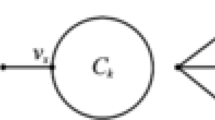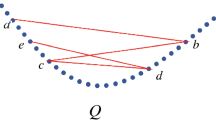Abstract
A well-known result of Kupitz from 1982 asserts that the maximal number of edges in a convex geometric graph (CGG) on n vertices that does not contain \(k+1\) pairwise disjoint edges is kn (provided \(n>2k\)). For \(k=1\) and \(k=n/2-1\), the extremal examples are completely characterized. For all other values of k, the structure of the extremal examples is far from known: their total number is unknown, and only a few classes of examples were presented, that are almost symmetric, consisting roughly of the kn “longest possible” edges of CK(n), the complete CGG of order n. In order to understand further the structure of the extremal examples, we present a class of extremal examples that lie at the other end of the spectrum. Namely, we break the symmetry by requiring that, in addition, the graph admit an independent set that consists of q consecutive vertices on the boundary of the convex hull. We show that such graphs exist as long as \(q \le n-2k\) and that this value of q is optimal. We generalize our discussion to the following question: what is the maximal possible number f(n, k, q) of edges in a CGG on n vertices that does not contain \(k+1\) pairwise disjoint edges, and, in addition, admits an independent set that consists of q consecutive vertices on the boundary of the convex hull? We provide a complete answer to this question, determining f(n, k, q) for all relevant values of n, k and q.









Similar content being viewed by others
Notes
Formally, \(L_j\) is the set whose distance to the vertex labelled n is smaller, where the distance dist(S, v) of a set of vertices S from a single vertex v is defined as \(dist(S,v)=\min _{s \in S} ord([s,v])\). A single exception is direction 0 for which the distances of both sets from vertex n are equal. For that direction, we choose for convenience \(L_0=\{n-1,\ldots ,n-(2k-1)\}\) and \(R_0=\{-(n-1),\ldots ,-(n-2k+1)\}\).
Note that in each direction, there are at least k allowed edges. Indeed, by the definition of A, the set \(A^c\) contains 2k vertices. Hence, at least k of the edges in each direction have an endpoint in \(A^c\).
References
Ackerman, E., Fox, J., Pach, J., Suk, A.: On grids in topological graphs. Comput. Geom. 47(7), 710–723 (2014)
Aichholzer, O., Cabello, S., Fabila-Monroy, R., Flores-Peñaloza, D., Hackl, T., Huemer, C., Hurtado, F., Wood, D.R.: Edge-removal and non-crossing configurations in geometric graphs. Discrete Math. Theor. Comput. Sci. 12(1), 75–86 (2010)
Alon, N., Erdős, P.: Disjoint edges in geometric graphs. Discrete Comput. Geom. 4, 287–290 (1989)
Brass, P., Moser, W., Pach, J.: Research Problems in Discrete Geometry. Springer, Berlin (2005)
Capoyleas, V., Pach, J.: A Turán-type theorem on chords of a convex polygon. J. Combin. Theor. Ser. B 56, 9–15 (1992)
Černý, J.: Geometric graphs with no three disjoint edges. Discrete Comput. Geom. 34(4), 679–695 (2005)
Dress, A., Koolen, J.H., Moulton, V.: On line arrangements in the hyperbolic plane. Eur. J. Combin. 23, 549–557 (2002)
Erdős, P.: On sets of distances of \(n\) points. Am. Math. Mon. 53, 248–250 (1946)
Felsner, S.: Geometric Graphs and Arrangements. Vieweg Verlag, Germany (2004)
Fox, J., Pach, J., Suk, A.: The number of edges in \(k\)-quasi-planar graphs. SIAM J. Discrete Math. 27(1), 550–561 (2013)
Harary, F., Schwenk, A.J.: The number of caterpillars. Discrete Math. 6, 359–365 (1973)
Jonsson, J.: Generalized triangulations and diagonal-free subsets of stack polyominoes. J. Combin. Theor. Ser. A 112, 117–142 (2005)
Keller, C., Perles, M.A.: On the smallest sets blocking simple perfect matchings in a convex geometric graph. Israel J. Math. 187, 465–484 (2012)
Kupitz, Y.S.: On pairs of disjoint segments in convex position in the plane. Ann. Discrete Math. 20, 203–208 (1984)
Pach, J.: Geometric intersection patterns and the theory of topological graphs (2015, preprint). http://www.cims.nyu.edu/~pach/publications/PachICM032314
Tóth, G., Valtr, P.: Geometric graphs with few disjoint edges. Discrete Comput. Geom. 22(4), 633–642 (1999)
Woodall, D.R.: Thrackles and deadlock. In: Welsh, D.J.A. (ed.) Combin. Math. Appl., pp. 335–347. Academic Press, London (1971)
Author information
Authors and Affiliations
Corresponding author
Additional information
This work was partially supported by the Hoffman Leadership and Responsibility Program at the Hebrew University.
Rights and permissions
About this article
Cite this article
Keller, C., Perles, M.A. On Convex Geometric Graphs with no \(k+1\) Pairwise Disjoint Edges. Graphs and Combinatorics 32, 2497–2514 (2016). https://doi.org/10.1007/s00373-016-1719-6
Received:
Published:
Issue Date:
DOI: https://doi.org/10.1007/s00373-016-1719-6




